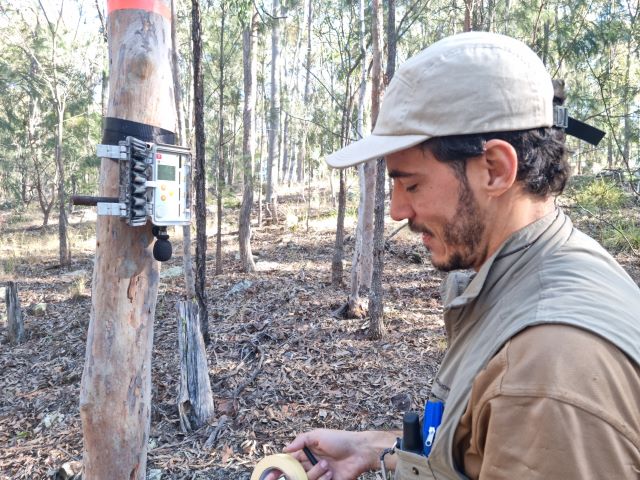Background
The demand for more effective (accurate and reliable) environmental monitoring methods has experienced an unprecedented surge in recent times, with the use of bio-acoustics emerging as a promising alternative (Browning et al., 2017). Acoustic indices offer a method to integrate acoustic and ecological information into a single value allowing for a rapid assessment and comparative approach (Suer et al., 2014; Buxton et al., 2018). Nevertheless, inconsistencies have been reported in the literature regarding the accuracy of these indices as proxies for biodiversity (Alcocer et al., 2022). Studies have identified potential issues such as unwanted noise input, pseudo recording replication, and inappropriate project design, which can compromise the accuracy and reliability of these indices. For example, it is crucial to carefully evaluate and filter the content in the recordings (Metcalf et al., 2021), establish ground-truth information (Allen-Ankins et al., 2023), understand the configuration of the indices and its implications (Harris et al., 2016; Bolgan et al., 2018), appropriately assess whether the associations serve the research question (Gasc et al., 2015), and consider the statistical representativeness of the recording samples (Towsey et al., 2014; Pieretti et al., 2015; Bradfer-Lawrence et al., 2019). This PhD study assesses the performance of a set of commonly used acoustic indices to monitor woodland habitat in south-east Queensland, while addressing the shortcomings reported in other studies.
Aims
- First, knowing that soundscapes are unique to specific habitats, the aim will be to describe the soundscape of a woodland in south-east Queensland, and the spatial and temporal variation thereof (considering sites, days, and seasons), using acoustic indices.
- Second, to provide an effective temporal sampling schedule to accurately capture diel cycles of soundscapes and avian diversity in south-east Queensland woodlands while taking seasonality into account.
- Finally, applying the outcomes of the second aim (sampling schedule efficiency), the effectiveness of acoustic indices to track spatial and temporal variation in woodland bird communities (species richness and number of calls) will be evaluated.
Methodology
Up to 12 survey sites in the Hidden Vale region and 6 survey sites in Mt Grandchester Conservation Estate are having the soundscape recorded. Survey sites have a minimum distance of 400m from each other or any edge effects to ensure sampling independence. The soundscape monitoring is being conducted continually for five weeks during each season (started in July/2023, concluding in April/2024).
The acoustic indices spectral entropy index (Hf) (Sueur et al., 2008), the temporal entropy spectrum index (Ht) (Sueur et al., 2008), the acoustic entropy index (H) (Sueur et al., 2008) , the acoustic complexity index (ACI) (Pieretti et al., 2011), the acoustic evenness index (AEI) (Villanueva-Rivera et al., 2011), the acoustic diversity index5(ADI) (Villanueva-Rivera et al., 2011), the bioacoustics index (BI) (Boelman et al., 2007) and the normalized difference soundscape index (NDSI) (Kasten et al., 2012) will be calculated from the acoustic sound file data through the R software using the seewave, soundecology, and tuneR packages (R Core Team, 2021). In addition, the sound data will also be used to estimate and identify bird species richness and number of calls by manual identification. Correlations between the number of bird species and number of calls per minute are going to be assessed with each one of the acoustic indices. For all analyses p<0.05 will be considered significant.

Expected Outcomes
Understanding the optimum acoustic sampling scheme needed to avoid exacerbated or insufficient sampling effort, or incorrect ecological interpretations when using soundscapes for habitat monitoring, will be an important outcome to assist managers with future monitoring efforts. In addition to understanding the optimum acoustic sampling effort needed to sufficiently describe the soundscape being examined, an important outcome will be to identify which indices (or combination of indices) is most affective in tracking patterns in the bird communities of Hidden Vale. Therefore, we hope to provide proof of concept for these indices to be used as a future monitoring tool to examine biodiversity outcomes associated with management actions such as habitat restoration within the woodlands of south-east Queensland.
References
Alcocer I., Lima H., Sugai L.S.M. and Llusia D., 2022, ’Acoustic indices as proxies for biodiversity: a meta‐analysis’, Biological Reviews, vol. 97, no. 6, pp. 2209-2236.
Boelman N.T., Asner G.P., Hart P.J. and Martin R.E., 2007, ‘Multi‐trophic invasion resistance in Hawaii: bioacoustics, field surveys, and airborne remote sensing’, Ecological Applications, vol. 17, no. 8, pp. 2137-2144.
Browning E., Gibb R., Glover-Kapfer P. and Jones K.E., 2017, ‘Passive acoustic monitoring in ecology and conservation’.
Buxton R.T., McKenna M.F., Clapp M., Meyer E., Stabenau E., Angeloni L.M., Crooks K. and Wittemyer G., 2018, ‘Efficacy of extracting indices from large‐scale acoustic recordings to monitor biodiversity’ Conservation Biology, vol. 32, no. 5, pp. 1174-1184.
Kasten E.P., Gage S.H., Fox J., Joo W., 2012, ‘The remote environmental assessment laboratory's acoustic library: an archive for studying soundscape ecology’, Ecological Informatics, vol.12, pp. 50-67.
Metcalf O.C., Barlow J., Devenish C., Marsden S., Berenguer E. and Lees A.C., 2021, ‘Acoustic indices perform better when applied at ecologically meaningful time and frequency scales’, Methods in Ecology and Evolution, vol. 12, no. 3, 421-431.
Pieretti N., Farina A., Morri D., 2011, ‘A new methodology to infer the singing activity of an avian community: the Acoustic Complexity Index (ACI)’, Ecological Indicators, vol. 11, pp. 868-873.
R Core Team, 2021. R: A Language and Environment for Statistical Computing. R Foundation for Statistical Computing, Vienna, Austria, http://www.R-project.org/
Sueur J., Pavoine S., Hamerlynck O., Duvail S., 2008, ‘Rapid acoustic survey for biodiversity appraisal’, PloS one, vol. 3, pp.12.
Sueur J., Farina A., Gasc A., Pieretti N. and Pavoine S., 2014, ‘Acoustic indices for biodiversity assessment and landscape investigation’, Acta Acustica united with Acustica, vol. 100, no. 4, pp. 772-781.
Villanueva-Rivera L.J., Pijanowski B.C., Doucette J. and Pekin B., 2011, ‘A primer of acoustic analysis for landscape ecologists’, Landscape ecology, vol.26, pp. 1233-1246.
Acknowledgements
- University of Queensland
- Hidden Vale Conservation Station
- Birdlife Australia
- Ipswich Council




